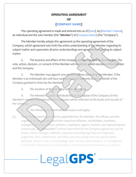Should Photographers Use a Client Agreement Template?
In today's visually-driven digital landscape, photographers face increasing business complexities that extend far beyond capturing compelling images....
8 min read
LegalGPS : May. 24, 2025
In today's visual-dominated digital landscape, photographers face increasing scrutiny over image rights, privacy concerns, and consent issues. Whether you're a professional photographer shooting commercial work, portraits, or events—or even a hobbyist capturing street photography—understanding and implementing proper consent documentation has become essential to protecting both your photography business and your subjects.


Legal GPS Pro
Protect your business with our complete legal subscription service, designed by top startup attorneys.
A common question among photographers is whether using a template for media consent forms is sufficient or if custom-drafted documents are necessary. This article explores the advantages and potential limitations of media consent templates, when they're appropriate to use, and how to implement them effectively in your photography practice.
A media consent form (also called a model release, photo release, or image release) is a legal document that grants permission to a photographer to use, publish, or distribute images of the subject for specified purposes. This document establishes the rights of both the photographer and the subject, creating clear expectations and legal protections for all parties involved.
A comprehensive media consent form typically includes:
Unlike informal verbal agreements, these written documents provide tangible evidence of consent that can protect photographers from future disputes or misunderstandings.
Using templates as the foundation for your photography consent documents offers several significant advantages:
Time and resource efficiency
Creating consent forms from scratch requires substantial time and legal knowledge. Templates provide a ready-made structure that allows photographers to focus on their creative work rather than legal documentation.
Cost-effectiveness
Quality templates typically cost between $20-200, significantly less than attorney fees for custom documents, which can range from $300-1,000 or more depending on complexity and location.
Incorporates standard legal language
Well-crafted templates include essential legal terminology and clauses that might be overlooked by photographers without legal expertise, providing a comprehensive foundation for consent.
Consistency across clients
Templates help ensure all your subjects receive the same information and protections, creating a more professional and equitable approach to consent.
Quick deployment for spontaneous shoots
Having template forms ready (both digital and print versions) allows photographers to capture spontaneous opportunities while still obtaining proper consent.

Media Consent and Release
Get our Media Consent and Release Form Template to legally use media featuring clients or employees. Ensure consent and protect the interests of your company.
Trusted by 1,000+ businesses to safeguard their LLCs.
While templates offer efficiency and cost savings, they come with potential drawbacks that photographers should consider:
May not address specific photography niches
Generic templates might not include provisions relevant to specialized photography fields such as medical photography, minor subjects, or culturally sensitive contexts.
Potential for outdated legal language
Laws regarding privacy, image rights, and data protection evolve rapidly. Templates may contain outdated provisions that no longer provide adequate protection.
Geographic limitations
Templates may not account for regional or international differences in privacy laws, creating potential compliance issues for photographers working across different jurisdictions.
One-size-fits-all approach
Templates designed for general photography may not address unique scenarios or client concerns that arise in specialized photographic work.
Elena, a wedding photographer with an established business, had always used a standard template for her photography releases. The template included specific language about social media usage and third-party sharing of images.
When a client's wedding was featured in a local magazine without the couple's knowledge, they initially blamed Elena for sharing their images without specific permission. However, Elena was able to reference the clause in her template-based consent form that explicitly permitted usage for "publication in print and digital media for promotional and portfolio purposes."
The agreement also included language about third-party usage rights, which covered the magazine's legal use of the images that Elena had provided. Thanks to the comprehensive nature of her template-based document, Elena avoided potential legal issues and maintained her professional relationship with the clients by clearly demonstrating she had operated within the agreed terms.
What made this template effective was that Elena had reviewed and modified it to specifically address wedding photography scenarios, including provisions for various types of publication and promotion that are common in the wedding industry.
The decision between using a template or investing in custom consent documentation depends on several factors:
Photography type considerations
Business scale factors
Client profile considerations
A strategic approach many photographers adopt is what I call the "Compliance Upgrade Strategy":
This tiered approach allows photographers to balance cost considerations with appropriate legal protection as their business grows.
Whether using a template or custom document, ensure these critical elements are included:
Clear identification
Full names and contact information for all parties, including the photographer, subject(s), and parent/guardian for minors.
Specific usage rights
Detailed description of how, where, and for how long images may be used, including specific platforms, media types, and geographic considerations.
Compensation details
Clear outline of any payment, image copies, or other consideration provided in exchange for consent, or explicit statement that no compensation is provided.


Legal GPS Pro
Protect your business with our complete legal subscription service, designed by top startup attorneys.
Limitations and restrictions
Any restrictions on image usage, including prohibited uses, editing limitations, or exclusivity provisions.
Term and termination
Duration of the consent and any conditions under which either party may terminate the agreement.
Liability provisions
Appropriate waivers and indemnification clauses that protect photographers from claims resulting from authorized usage.
Legal documents are often filled with complex terminology that can intimidate subjects. The readability balance technique helps make your consent forms more approachable while maintaining legal protection:
This approach increases understanding and comfort with the consent process without sacrificing legal protection.
Original Template Text: "The Photographer is hereby granted the unrestricted right and permission to copyright, use, and publish photographic portraits or pictures of the Subject for art, promotion, advertising, trade, or any other lawful purpose whatsoever."
Customized Version: "Jane Smith Photography is granted permission to use images from this family portrait session for: (1) the photographer's portfolio (print and online), (2) social media accounts operated by Jane Smith Photography, (3) photography competition entries, and (4) the studio's website and promotional materials. Images will NOT be sold to stock photography services or used in paid advertising without separate written consent and compensation."
Notice how the customized version:
When implementing template-based consent forms, photographers should be aware of these important legal considerations:
Age of consent variations Requirements for minor subjects vary by location, with different rules for parental consent, subject age thresholds, and documentation requirements.
International privacy regulations Photographers working internationally should be aware of regulations like GDPR (Europe), PIPEDA (Canada), and CCPA (California) that may impact consent requirements.
Different requirements by photography type Commercial photography typically requires more comprehensive releases than editorial or artistic photography, with specific provisions regarding endorsement and commercial gain.
Evolving digital rights considerations As technology develops, new considerations around facial recognition, AI usage, and data extraction from images continue to emerge in legal frameworks.
Establish a regular schedule for reviewing and updating your consent documentation:
This systematic approach ensures your consent forms remain current with evolving legal standards while demonstrating due diligence in your business practices.
Having well-crafted consent forms is only effective if properly integrated into your workflow:
Digital vs. paper implementation
Timing and presentation
Storage and management
Are verbal agreements sufficient for photography consent?
While verbal agreements may have some legal standing, they're difficult to prove and lack specific details about usage rights. Written consent forms provide significantly stronger protection.
Do I need different templates for different types of photography?
Ideally, yes. Commercial, portrait, street, event, and editorial photography each have unique considerations that should be reflected in your consent documentation.
Can I use the same consent form for adults and minors?
No. Consent forms for minors require additional provisions, including parental/guardian signatures and potentially more restricted usage rights depending on your location.
How long should I keep signed consent forms?
Most legal experts recommend retaining consent forms for the duration of your usage of the images plus the statute of limitations period in your jurisdiction (typically 2-6 years).
Do I need consent forms for public events or street photography?
Legal requirements vary by location, but consent forms are always recommended for specific subjects featured prominently in images, even in public settings. Some jurisdictions have specific requirements for street photography.
Media consent templates offer photographers a valuable starting point for establishing legally sound relationships with their subjects. While templates shouldn't be used without customization and consideration of your specific photography practice, they provide an accessible and cost-effective foundation compared to entirely custom-drafted documents.
The most effective approach for most photographers is to:
This balanced strategy helps protect your photography business while maintaining professionalism without excessive legal costs. Remember that as your photography business grows and diversifies, your consent documentation should develop accordingly.
What steps will you take today to strengthen the consent process in your photography business?
The biggest question now is, "Do you need a lawyer for your business?” For most businesses and in most cases, you don't need a lawyer to start your business. Instead, many business owners rely on Legal GPS Pro to help with legal issues.
Legal GPS Pro is your All-In-One Legal Toolkit for Businesses. Developed by top startup attorneys, Pro gives you access to 100+ expertly crafted templates including operating agreements, NDAs, and service agreements, and an interactive platform. All designed to protect your company and set it up for lasting success.

Legal GPS Pro
Protect your business with our complete legal subscription service, designed by top startup attorneys.
|
Premium Template
Single-use Template |
Legal GPS Pro
Unlimited Access, Best Value |
|
|
| Choose Template | Learn More |
| Trusted by 1000+ businesses | |
Table of Contents

In today's visually-driven digital landscape, photographers face increasing business complexities that extend far beyond capturing compelling images....

In today's rapidly expanding coaching industry, establishing clear professional boundaries has never been more important. As more individuals and...

In the dynamic world of public speaking, where your words and expertise can inspire audiences and transform organizations, one critical business...